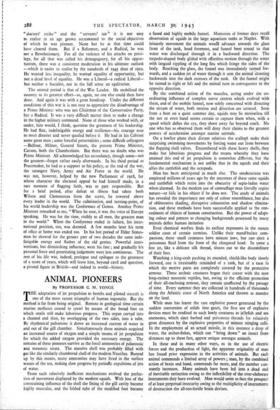ANIMAL PIONEERS
By PROFESSOR C. M. YONGE From such relatively inefficient mechanisms evolved the perfec- tion of movement displayed by the modern squids. With loss of the constraining influence of the shell the lining of the gill cavity became highly muscular, and the folded tube of the modified foot became a fused and highly mobile funnel. Memories of former days recall observation of squids in the large aquarium tanks at Naples. With leisurely movement the animals wourd advance towards the glass front of the tank, head foremost, and funnel bent round 5o that water was discharged through it in a backward direction. The torpedo-shaped body glided with effortless motion through the water with languid rippling of the long fins which fringe the sides of the body. Reaching the glass, the funnel was immediately turned for- wards, and a sudden jet of water through it sent the animal shooting backwards into the dark recesses of the tank. Or the funnel might be turned to right or left and the animal turn in consequence in the opposite direction.
By the combined action of the muscles, acting under the co- ordinating influence of complex nerve centres which evolved with them, and of the mobile funnel, now solely concerned with directing the stream of water, both motion and direction are secured. Seen from a boat on a quiet summer day, squids may lie motionless till the net or even hand seems certain to capture them when, with a speed which defies the eye, they shoot away far beyond reach. No one who has so observed them will deny their claims to the greatest powers of acceleration amongst marine animals.
On a lowlier plane their distant relatives the scallops make their surprising swimming movements by forcing water out from between the flapping shell valves. Encumbered with these heavy shells, they make but laborious progress and the means whereby they have attained this end of jet propulsion is somewhat different, but the fundamental mechanism is not unlike that in the squids and their allies the cuttlefish and the octopods.
Man has been anticipated in much else. The smokescreen was employed millions of years ago by the ancestors of these same squids and cuttlefish which retire into the obscurity of sepia-laden water when alarmed. In the modern use of camouflage man literally copies nature—or fails in his object if he does not. The study of animals has revealed the importance not only of colour resemblance, but also of obliterative shading, disruptive colouration and shadow elimina- tion, and these methods have been successfully applied to the con- cealment of objects of human construction. But the power of adapt- ing colour and pattern to changing backgrounds possessed by many animals defies human imitation Even chemical warfare finds its earliest exponents in the nasute soldier caste of certain termites. Unlike their manclibulate com- panions, these small creatures have minute jaws, but can eject a poisonous fluid from the front of the elongated head. In some a fine jet, like a delicate silk thread, shoots out to the discomfiture of their foes.
Watching a king-crab pushing its rounded, shield-like body slowly forward, one is irresistably reminded of a tank, but of a tank in which the motive parts are completely covered by the protective armour. These archaic creatures began their career with the now long-extinct mesozoic reptiles, but, owing ta the efficient protection of their all-enclosing armour, they remain unaffected by the passage of time. Every summer they are collected in hundreds of thousands along the Atlantic coast of North America and thrown as manure on the land.
While man has learnt the vast explosive power generated by the sudden conversion of solids into gases, the first use of explosive devices must be credited to such lowly creatures as jellyfish and sea anemones, which eject barbed and poisonous threads for relatively great distances by the explosive properties of minute stinging cells. In the employment of an actual missile, in this instance a drop of water, the archer-fishes, which can "bring down" an insect from distances up to three feet, appear unique amongst animals.
In these and in many other ways, as in the use of electric forces and the production of light, the apparent originality of man has found prior expression in the activities of animals. But each animal commands a limited array of powers ; man, by the combined action of brain and hand, commands far more, and the number con- stantly increases. Many animals have been led into a .dead end of inevitable extinction owing to the inflexibility of the over-elaborate instruments they have evolved. Man would seem to face the prospect of at least perpetual insecurity owing to the multiplicity of instruments of destruction the all-too-fertile brain devises.






















 Previous page
Previous page